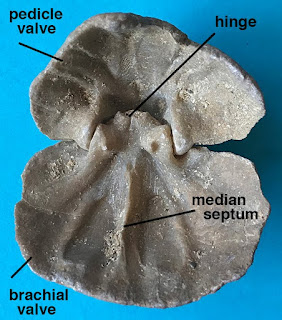This post is the second of two parts, and this one pertains only to the articulate brachiopods.
Articulate brachiopods, which have their two valves held together by teeth and sockets, are epifaunal (attached to hard surfaces by means of a short pedicle) animals. Their shells consist of calcite. This group of brachiopods has a geologic range of Cambrian to Recent.
One of the most important organs of all brachiopods is the lophophore. It consists of two ciliated coiled tentacles (brachia), whose function is to circulate water, distribute oxygen, and remove carbon dioxide. water currents generated by the cilia move food particles toward the mouth.
The following image shows two views of a specimen of the modern-day articulate brachiopod Laqueus californicus, which is found off Catalina Island, southern California, in waters depths between 240 and 300 feet deep. The valves are egg-shell thin and allow some light to pass through them.
Brachial-valve view (width 37 mm).
Side view showing the commissure (the margin separating the two valves). The valves (width 37 mm), which barely open up, do so just far enough to see the delicate structure that supports the lophophore. Any further opening would break the hinge. width 31 mm
The following three images are of a closed-valved, complete specimen of the articulate brachiopod Terebratalia hemphilli Dall, 1902, from upper Pliocene (about 2.5 million-years old) sandstone in Los Angeles County, southern California. The specimen has a thickness (both valves together) of 6.25 cm. The specimen is 6.25 cm height and 5.3 cm wide.
side view
Brachial-valve view.
Pedicle-valve view.
The next image is a another T. hemphilli from the same locality as the previous specimen and shows the partial interior views of both valves (a rare sight!). The maximum width of this partial specimen is 4.2 cm. Its hinge still works. Its two valves move back-and-forth and have no tendency to separate.
It is important to mention, at this point, that although brachiopods are "bivalved" (= consists of two valves) and can resemble some clams (bivalves), brachiopods and clams are NOT the same phylum! There are numerous soft-bodied differences (e.g., brachiopods have a lophophore, whereas clams do not) and there are numerous differences in shell characteristics (e.g., there hinges are different, the interiors of their valves are different, and brachiopod valves have a pedicle opening (foramen), although the foramen might not be obvious on some brachiopods.
Articulate brachiopods were extremely abundant in shallow-marine faunas during Ordovician through Permian times. After the Late Permian mass extinction, they declined in diversity and never returned to the "glory days." Today, they are minor constituents in marine faunas, and some have seeked deeper waters as a refuge. Below are some examples of commonly found Paleozoic articulate brachiopods.
Ordovician, two views of same specimen, 33 mm width.
A Late Paleozoic articulate referred to as a spiriferid (has elongate "wings").
Two views of a Late Paleozoic articulate brachiopod referred to as a productid. This group is characterized by having one of its valves convex, and the corresponding valve is concave.













No comments:
Post a Comment